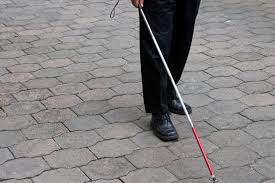 The National Eye Institute (NEI), part of the National Institutes of Health, is funding several new technologies and tools being created to help the 4.1 million Americans living with low vision or blindness. The tools are designed to help people manage daily tasks such as navigating office buildings, crossing streets, and recognizing images and objects.
The National Eye Institute (NEI), part of the National Institutes of Health, is funding several new technologies and tools being created to help the 4.1 million Americans living with low vision or blindness. The tools are designed to help people manage daily tasks such as navigating office buildings, crossing streets, and recognizing images and objects.
Here is a look at some of these NEI-funded technologies:
Co-robotic cane
Cang Ye, Ph.D, of the University of Arkansas at Little Rock, has developed a co-robotic cane that provides feedback on a user’s surrounding environment. The cane prototype has a computerized 3-D camera that can “see” on behalf of the user. It also has a motorized roller tip that can propel the cane toward a desired location, allowing the user to follow the cane’s direction toward a destination. The user can speak into a microphone and a speech recognition system interprets verbal commands and guides the user via a wireless earpiece.
Robotic glove finds door handles, small objects
Ye also developed a fingerless glove that uses a camera to detect small objects such as door handles. There is a speech recognition system on the back surface of the glove that the user speaks commands into such as “door handle,” “mug,” or “water bottle.” The glove uses tactile prompts to the desired object. An actuator on the thumb’s surface guides the person’s hand left or right.
Ye’s colleage Yantao Shen, Ph.D., University of Nevada, Reno, developed a hybrid tactile system that consists of an array of cylindrical pins that send either a mechanical or electrical stimulus. The stimulus excites the nerves on the skim of the hand to simulate a sense of touch and direct the hand to move backward.
Smartphone Crosswalk App
James Coughlan, Ph.D., and his colleagues at the Smith-Kettlewell Eye Research Institute, have developed a smartphone app that gives auditory prompts to help users identify the safest location for crossing then helps them stay within the crosswalk.
CamIO system that helps explore objects in a natural way
This system incorporates a camera connected to a laptop computer, and it makes physical objects, from 2-D maps to digital displays on microwaves accessible to people with low vision or blindness. Users explore the object by holding their finger on it, and the system provides audio feedback.
High-powered prisms, periscopes for severe tunnel vision
Eli Peli, O.D., of Schepens Eye Research Institute, Boston, has developed lenses constructed of adjacent one-millimeter wide prisms that expand the visual field while preserving central vision. He designed a high-powered prism that expands field of view by about 30 degrees, then with colleagues developed a periscope-like effect using non-parallel mirrors that allows for a 45-degree visual field. The next step is to work with optical labs to manufacture a cosmetically acceptable prototype that can be mounted onto glasses.
Based on an article by Kathryn Demott at nei.hih.gov.
